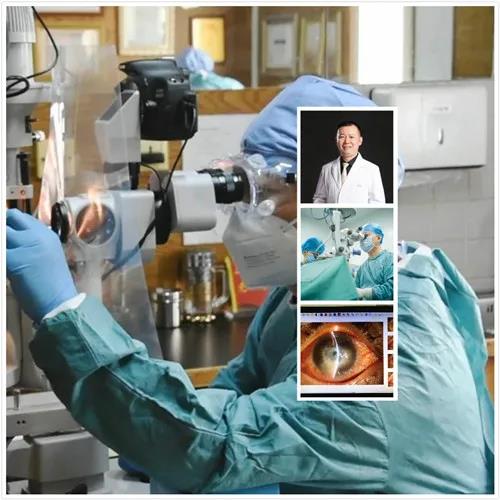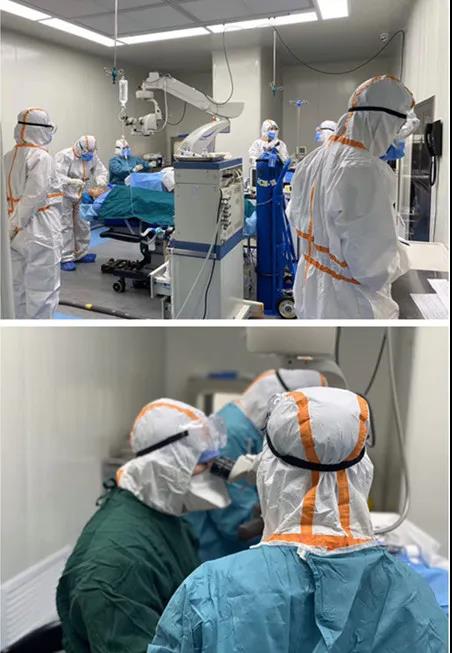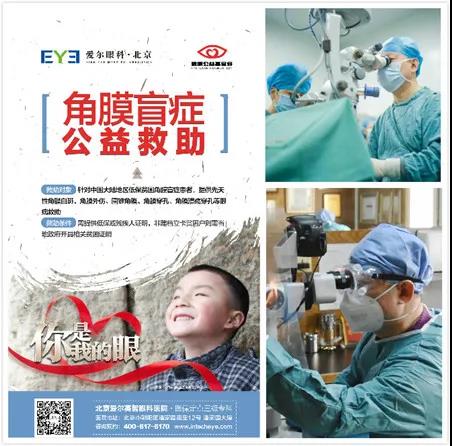"It is only over half a month following her surgery. If there is no recurrence within a month, then we can say the operation is successful, because I am afraid that the fungal infection will recur."Dr Li Shaowei, the chief surgeon of Mrs. Song's corneal transplant surgery. He said Mrs. Song had returned to a local hospital for re-examination, until now she is in good condition. We have been keeping in touch, following her recovery status remotely.
This is an unusual case. Even for Dr. Li Shaowei, the director of Beijing AIER Intech Eye Hospital, who is a well-known expert in corneal disease, the treatment process is still a thrill. At the sametime, behind this case, it also reflects the difficulty of the development of domestic corneal transplantation.
01 Viral Keratitis?
Mrs. Song, from Dalian, Liaoning Province, had suffered from viral keratitis for over 20 years. During these years, the only thing she depended on for her disease was medication, for which her condition kept repeating and lingering. However, every time her eye got worse, the medication could only release her symptom temporarily.
Mrs. Song might have still been putting off her treatment if not for a burst corneal perforation. One day two months ago, she suddenly had symptom as photophobia, tearing and increased secretion. At first, she didn’t pay much attention, and thought it was just another normal recurrence of keratitis, which could be alleviated by medication as usual. Also, due to the outbreak of COVID-19, it was not really convenient to go to a hospital.
But this time Mrs. Song wasn't getting better after taking medicine. Instead, her eyes got unbearably painful and her vision was seriously impaired. When visiting the local hospital, she was suspected of having a fungal infection. However, the epidemic prevention and control situation was quite strict, and some examinations could not be carried out, therefore her symptom could not be diagnosed definitively. The doctor then tried to use a variety of anti-fungal, anti-viral and anti-bacterial medicine for Mrs. Song, which yet had little effect. Her corneal ulcers were getting bigger and bigger, which then even caused intraocular empyema.
Under this circumstance, the local doctor immediately thought of Dr Shaowei Li, a well-known domestic corneal transplant expert and also CEO of Beijing AIER Intech Eye Hospital. After contact, Dr. Li conducted a remote consultation for Mrs. Song through the Internet. Since there was no further examination, Dr. Li gave his treatment recommendation – to have the corneal transplantation and remove the infected lesions as soon as possible to save the eyeball.

However, according to the regulation to prevent COVID-19 in Beijing, one needed to be quarantined for 14 days after arriving in Beijing, which means that Mrs. Song would not be able to receive a surgery immediately. After adequate communication and consideration, Mrs. Song and her families decided to come to Beijing to get quarantined while waiting for the surgery.
At that time, Dr. Li and his team informed all eye banks of AIER Eye Hospital Group in the first place looking for the proper corneal for Mrs. Song, during which, kept contacting with Mrs. Song checking on her disease progress and providing medication instruction.
Dr. Li decided to do whatever it takes to save Mrs. Song’s eye. He had even prepared for the worst, “if her infection get worse or there is a corneal perforation during her quarantine, we will still perform the surgery even in protective suit!”.
After 10 days in this torment, Mrs. Song called on the 11th day and said, "I felt a sudden burst of tears in my left eye!" Dr. Li immediately conducted a video consultation with her. Although he could not see all the details clearly without examination under microscope, he made a judgment – it was corneal perforation. Then Dr. Li made a prompt decision, which is to conduct the operation to rescue her eye.
Here comes the beginning of an "eyeball defense battle" in Beijing AIER Intech Eye Hospital. Dr.Li contacted every AIER eye bank again urgently looking for a corneal to save Mrs.Song’s vision.
02 A Close Call!
Affected by the epidemic, the amount of corneal donations decreased sharply, which made even more difficult to obtain donated cornea. Thanks to Dr. Li Shaowei team's putting her need on record in advance at each eye bank of the AIER Group. On the third day following Ms. Song's corneal perforation, Chengdu AIER Eye Bank received a donated cornea. At the same time, Mrs. Song’s 2-week quarantine was lifted. She was immediately admitted to the hospital and the cornea from Chengdu AIER Eye Bank was transported by air urgently.
With the donated cornea, it was hopeful to treat Mrs. Song’s eyes, which contributed to the system of AIER Eye Bank. Since the establishment of the first Eye Bank in 2006, AIER Eye Bank has developed rapidly following national policy and regulations. At present, there are 10 AIER Eye Banks in AIER Eye Hospital, as well as 29 cornea donation receiving stations nationwide. It has become the biggest nationwide network of cornea donation, over 1000 corneas being donated annually. According to Dr. Li, “it provides timely and effective transplant surgical information and assistance for more blindness patients.”
April 1st was the day when Mrs. Song was scheduled to have corneal transplant, but plan was disrupted again. The glass container of cornea was broken accidentally during air transportation, causing the precious cornea contaminated and to be unable to use.

At the crucial moment, the advantages of AIER Eye Bank were seen again. Dr. Li once again sent a message to AIER Group Eye Bank. In the afternoon of the same day, news came from Changsha AIER Eye Bank that they obtained two fresh corneas. One had been used for a patient with corneal perforation, and the other one was planned for a patient with corneal leukoplakia who had been already hospitalized and waiting for surgery.
Dr. Li said, "Ms. Yang Lihong, Director of the Changsha AIER Eye Bank, and Ms. Wang Congxiang, Director of the Department of Corneal Diseases, talked to the patient who was ready for his surgery about Mrs. Song’s situation. The patient was very reasonable and agreed to give up the opportunity to Mrs. Song. We are very grateful for his sacrifice. The cornea was urgently airlifted to Beijing that night. "

The corneal transplant operation was very successful, and Mrs Song's left eye was saved. However, the risk of recurrence of fungal infections still exists. Because steroid can’t be used with fungal keratitis, however, steroid is the main drugs for anti-rejection after transplantation. Therefore, risk of rejection still exists.
Compared to save her eyes, it’s only could be chosen the lesser of two evils. So far, the cornea transplanted by Mrs. Song is still very clear. Dr Li plans to resolve her cataract problem after her condition being stable.

03 The Scarcity of Corneal Resources
When she was discharged from the hospital, Mrs. Song and her son expressed great appreciation to Dr. Shaowei Li 's team again and again.
However, if the surgery hadn't been delayed for such a long time leading to cornea perforation, she could have had a better prognosis with lower postoperative risk. Mrs. Song's experience also reflects the backwardness of China's corneal transplantation field.
According to the ratio between the number of corneal transplant operations and population in the United States annually, Dr. Shaowei Li speculates that the conservative estimate of performed corneal transplants cases in our country should be 160,000 to 200,000 annually. However, the actual number of corneal transplants conducted in China is less than 10,000 per year. A large number of patients are not able to get treated, some of which may lose their eyesight forever.
The main reason for this problem is the lack of cornea resources. As a late comer organ transplantation donation business, China used to be one of the countries with the lowest organ donation rate in the world. From January 1st, 2015, voluntary donation just has become the only channel for organ transplantation.
As a human tissue, cornea is far from being attached great importance. Lack of protection of corresponding laws and regulations, it has not been included in the national organ donation distribution system. The current status of corneal distribution in China is that the organ donation center will give the cornea priority to the ophthalmology department of public hospitals. Those hospitals, due to their easy access to donated corneas, lack the motivation to persuade new donors, which results in the development lag of corneal donation. The gap of corneal donor now is huge and cannot meet the needs of corneal blindness. Some ophthalmologists even try to transplant pig cornea onto their patients.
"There is no need to go that way. As long as we all try our best to persuade donors, loosen the approval procedure of the eye bank and enable those doctors who are interested and dedicated to this career, there will not be a lack of cornea anymore.” Said Dr. Li, “The eye bank should refer to the construction model of blood stations. In the US, there are 120,000 corneas being donated every year, with lots of corneas to spare, which would be used for research and export. Our population is several times that of the United States, yet the cornea is so scarce.”

"As long as it’s allowed to develop eye bank and operating it under regulations, cornea resources will not be deficient naturally and this professional field will naturally develop." Dr Li frankly said, "AIER Ophthalmology Group has made a lot of efforts for establishing eye bank, and has obtained some experience and achieved some achievements, which is a powerful supplement to the construction of national eye bank system. "
Depending on the power of Aier Ophthalmology Group, Dr. Li is striving to influence the industry. In recent years, with the promotion of Dr. Li, the charity project—— "You Are My Eye" has successively brought light to over 400 people suffering from corneal blindness.
Besides helping patients with corneal diseases, the team of expert also attaches great attention to the academic atmosphere and the training of corneal doctors locally, conduct corneal public education, promote the construction of corneal disease diagnosis and treatment centers and corneal banks in western region, and help to improve the overall diagnosis and treatment of corneal diseases in China.
Dr. Li holds the belief that they will first make a model and set an example for the industry, and maybe some late comers will keep up with.
